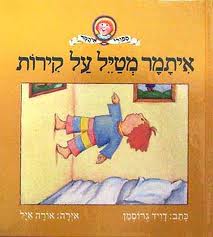Hebrew Children’s Literature and the Adult Learner of Hebrew
Rahel Halabe
Chapter 8c – Level Bet (Low-Intermediate level)

Itamar Walks on Walls איתמר מטייל על קירות
Written by David Grossman כתב דוד גרוסמן
Illustrated by Ora Ayal ציירה אורה אייל
David Grossman’s (1954- ) novels have long been considered an important part of the Modern Hebrew literature canon. Grossman has dealt deeply and creatively with a wide range of Israeli, Jewish and general human problems. In his writings, he investigates the Holocaust, and its effect on the second generation, as well as Arab-Israeli animosity; the struggle of children and youth to make sense of the world around them and to find their place in it; along with the various aspects of human relationships.
Grossman has also entered the canon of Hebrew young adult literature (i.e. Someone to Run With, mentioned in the previous chapter) and children’s literature in general. He began writing for children when raising his own children. איתמר מטייל על קירות Itamar Walks on Walls was his first book for children (to read English translation click on itamar-walks-on-walls-translation ).
Itamar has three colourful pictures in his room; one shows a train, the second – a girl flying a kite, and the third – a lion and a lioness in a forest. Itamar has a secret. Each night, just before falling asleep, he puts his feet on the wall and starts waking on it. He reaches the picture of the forest, climbs its frame and enters it. He roams around for a while, then goes back to bed and falls asleep. One night, while in the forest, he comes across the very worried lion and lioness. They tell him that their little cub rode a train few days before and never came back. Remembering that he saw the cub in the train picture, looking out of one of the train car windows, he offers his help. He walks to the picture with the girl, borrows her kite, flies it to the train picture, makes the cub jump on it, and returns him to his overjoyed parents. Back in bed, and before falling asleep, he is pleased to see the lion family happily cuddled together in the picture of the forest in front of him.
Grossman’s writings for children do not fit Zohar Shavit’s model of ambivalent children’s literature (see above, p. 7). Adult readers however, will recognize in his children’s stories deeper layers of meaning,.These qualities are not the result of conscious manipulation meant to push new forms and gain access to recognition of elite group of readers, as suggested by Shavit. Grossman already had his place in the centre of the Hebrew literary polysystem when he started writing for children. A writer of his stature can’t help but create thoughtful, complex and artful works, whether these are for adults, youth or children. Here are two examples that can be used to start a conversation in an adult Hebrew class:
1. Itamar enters his favourite picture, and the narrator comments:
כשנכנסים לתוך תמונה רואים ושומעים דברים שלא רואים ולא שומעים מבחוץ.
When you enter a picture, you see and hear things, that you cannot see or hear from outside.
Indeed, getting closer to the picture, roaming around and investigating it, open in front of Itamar its richness and its magic. He discovers in it all the wonders that were not apparent on its surface. Adult students can be asked to take the above sentence metaphorically and suggest examples, in which things look different from the inside than from the outside; the deeper symbols as opposed to the superficial image: stories in the news; natural phenomena; works of art; a visit to a foreign country etc.
2. Itamar shows the lions that their missing cub is riding the train in the picture on the opposite wall. He suggests that they go and bring him back, but:
… האריות הסבירו לו שהם אינם יכולים לצאת מן המסגרת של התמונה. רק מי שקטן מאד-מאד, כמו גור או כמו ילד, יכול להיכנס ולצאת מן המסגרת.
…the lions explained to him, that they cannot go out of the frame. Only those who are very, very small like a cub, or like a child can go in and out the frame.
The students are asked to interpret this statement. Is it imagination, courage, flexibility, that allows the young ones to move freely and easily from one framework to another? Do all of us lose our imagination when growing up? Have they lost their imagination? Who are the people who keep using their imagination as adult? Are they artists, scientists, inventors, etc? These questions, derived from an entertaining children’s story, are not trivial. Adult students at this level are able to discuss them thoughtfully with the language they have acquired.
On a more concrete level, Itamar’s story is used to reinforce the future tense introduced in the Bet Mini Ulpan level. After listening to each of the first four chapters and retelling it, the students are asked to predict ‘what will happen next’ using their familiar and newly introduced verbs in the future tense.
Grossman’s story can thus be used for a relaxing story time period at the end of an intensive study day. It reinforces the grammatical and lexical material imparted in the course and at the same time allows the students to emerge out of the simplistic issues usually treated up to this level (beginning of Bet). Through this process, they can try to deal with and express themselves using more abstract questions befitting their adult intellectual level and interests. Moreover, Itamar’s story is a good opportunity to introduce the students learning Hebrew to one of the most important Hebrew writers today. Until they can reach the level in which they can read his novel in Hebrew, they can be encouraged to read some of his writings translated into their first language.
back to: Hebrew Children’s Literature and the Adult Learner of Hebrew , by Rahel Halabe
